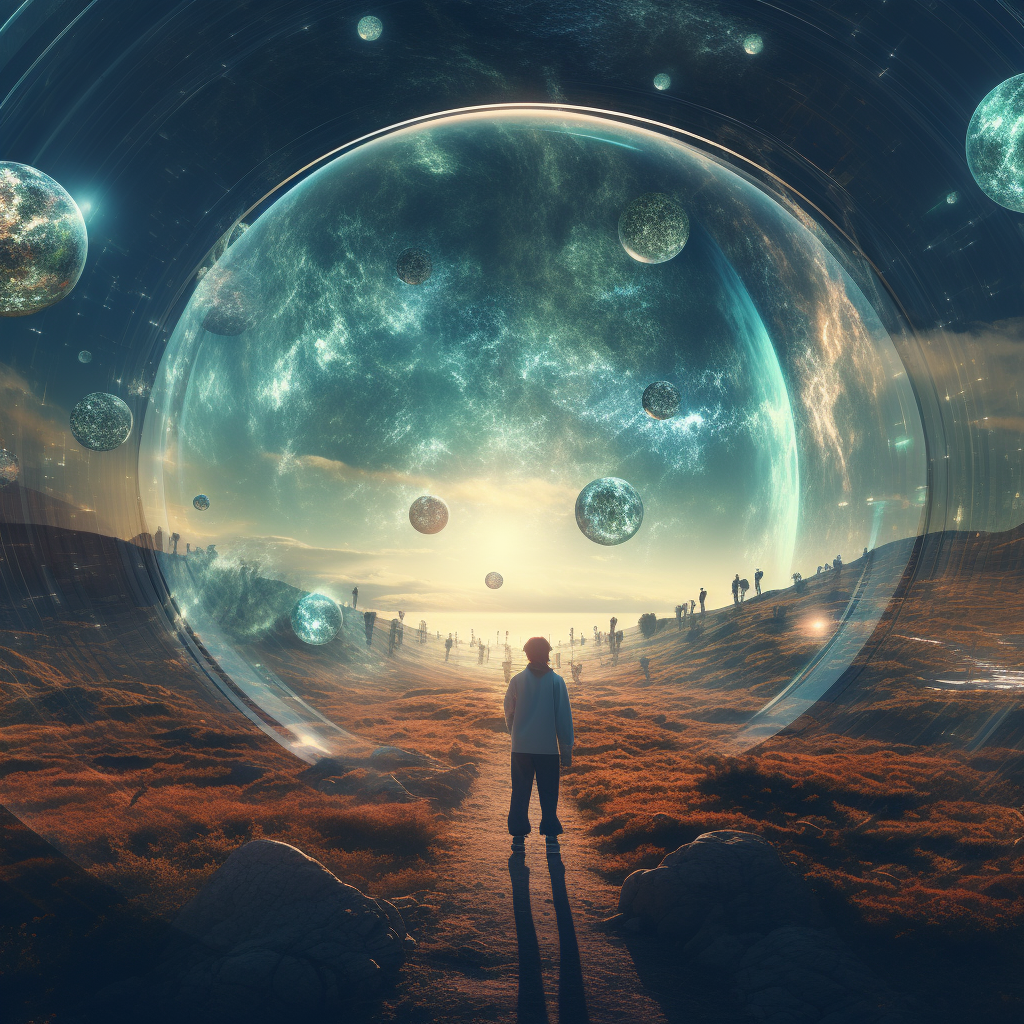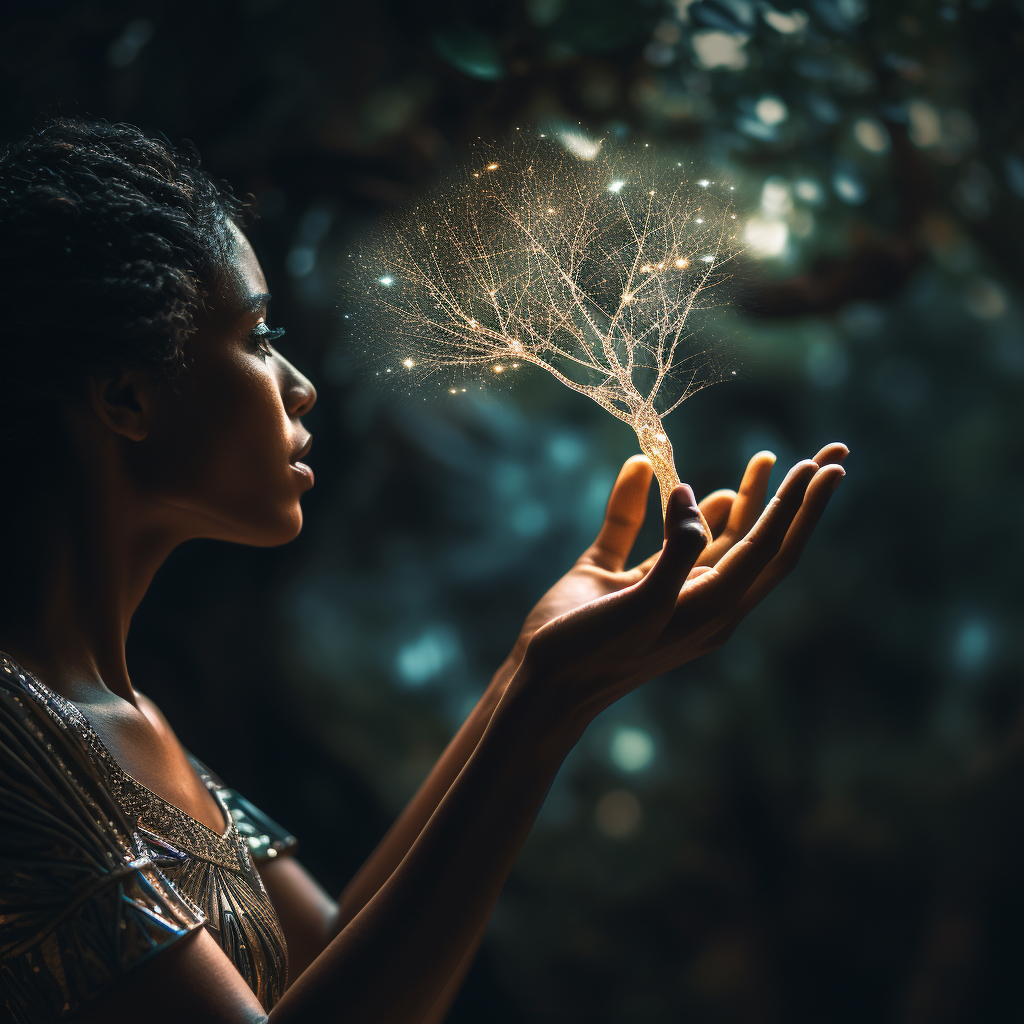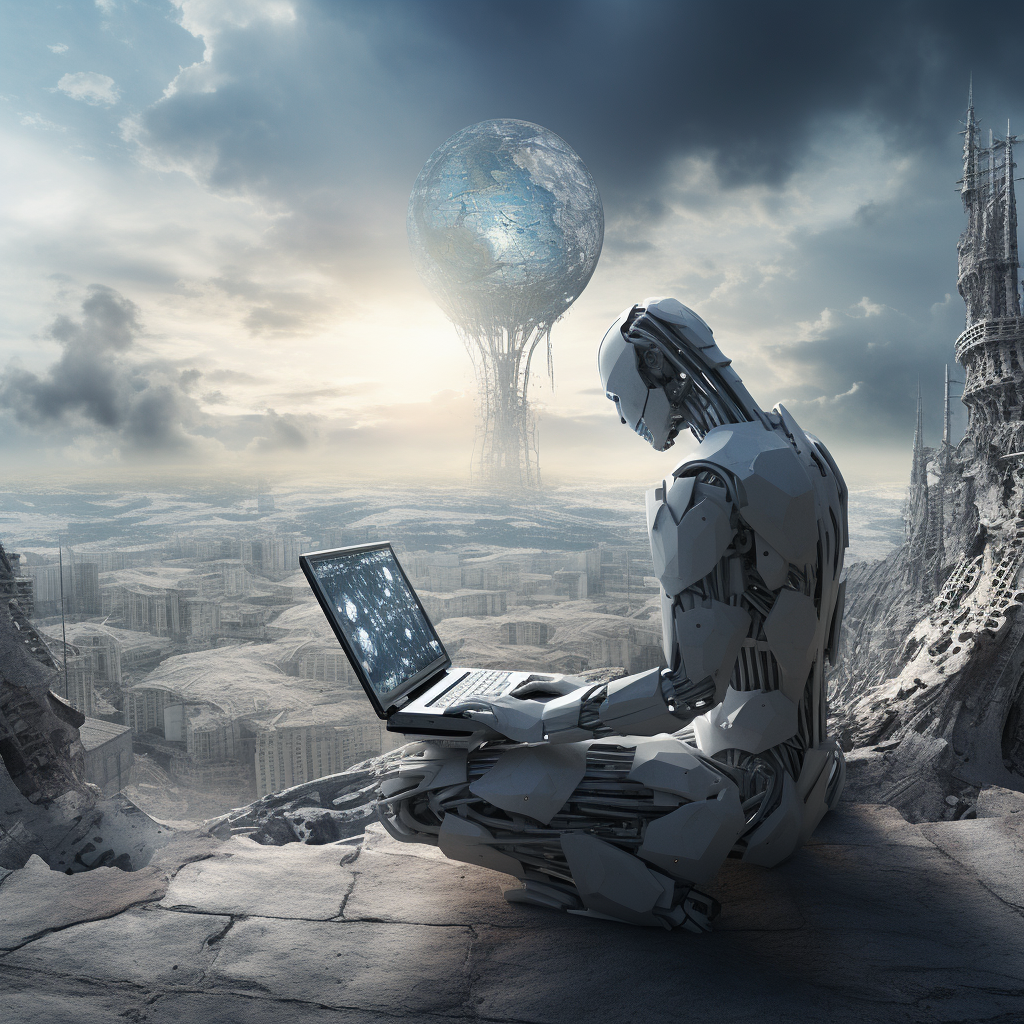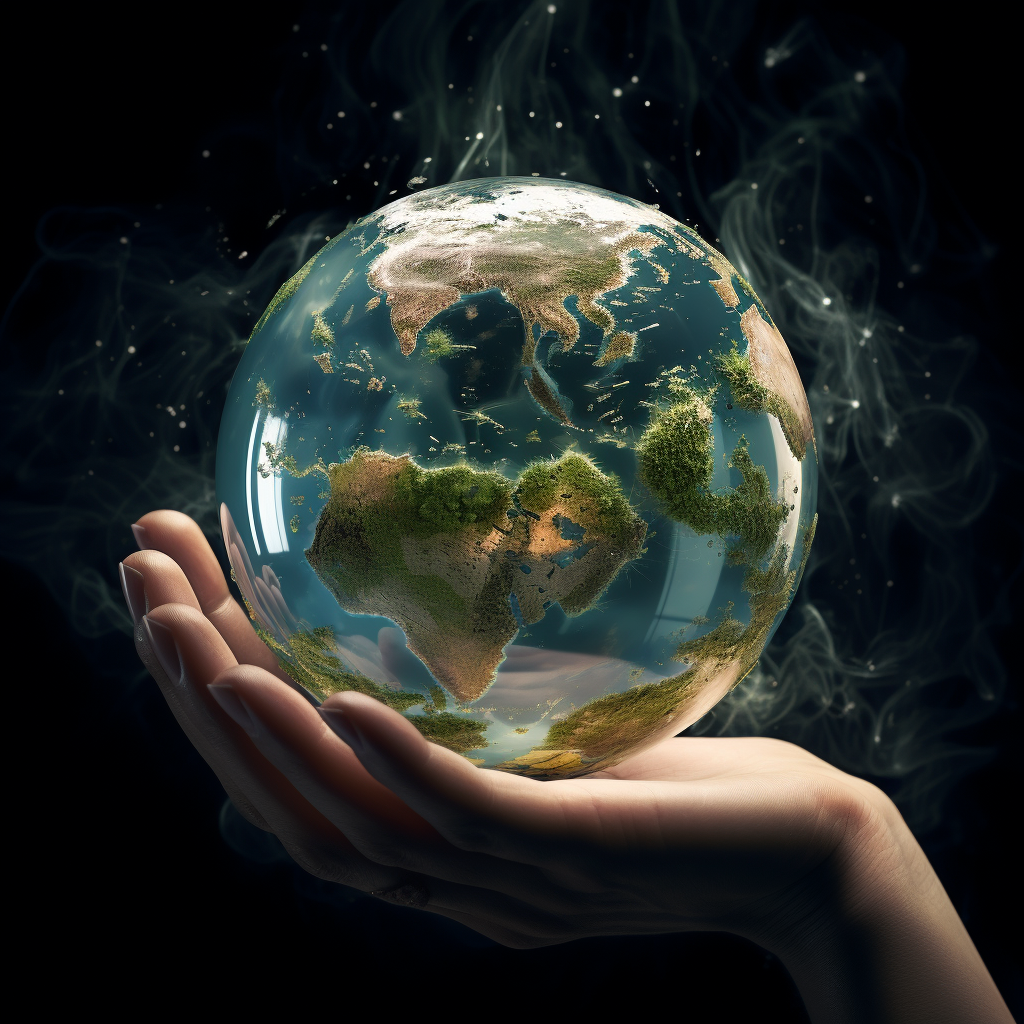In the year 2578, the Earth was a lush Eden. Towering forests grew untouched, oceans teemed with marine life, and vast plains pulsed with herds of wildlife. Until the Back-to-Earth Movement began.
In the year 2578, Earth had been transformed into a resplendent Eden, a testament to nature’s resilience and robotic stewardship. Towering forests, ancient and venerable, stretched across continents. Gigantic trees with thick, gnarled trunks rose majestically, their canopies a tapestry of green, dappling the forest floors with shifting patterns of light and shadow. Delicate ferns and vibrant flowers carpeted the undergrowth, creating a mosaic of colours that shimmered in the soft forest light.
Oceans, clear and abundant with life, were a miraculous shade of azure, stretching far beyond the horizon. Coral reefs, once endangered, now flourished in the shallow waters, a riot of colours beneath the waves. Schools of fish, iridescent and varied, darted between the corals, while larger creatures like graceful manta rays and ponderous whales traversed the deeper currents, lords of this underwater realm.
Vast plains, stretching as far as the eye could see, were home to a rich diversity of wildlife. Herds of animals, some resembling the ancient species of the past, roamed freely. Majestic creatures with coats that shimmered under the sun grazed peacefully, their movements a rhythmic dance in harmony with the wind-swept grasses. The grasslands were a canvas of golds, greens, and browns, waving in the gentle breezes, a sea of tranquility under the vast, open sky.

Above it all, the sky was a vibrant canvas, with the sun casting a warm, nurturing glow over the landscape. At night, the heavens were a blanket of stars, untouched by light pollution, each star a twinkling point in a vast, cosmic sea.
Robots, the diligent guardians of this rejuvenated Earth, moved with grace and precision across the landscape. Some were small, insect-like machines pollinating plants and spreading seeds. Others, larger and more imposing, patrolled the forests and plains, their sensors continuously monitoring the health of the ecosystem. They tended to the Earth with a gentle, yet unerring efficiency, ensuring that nutrients were evenly distributed, that every plant received its share of sunlight and water, and that the delicate balance of nature was maintained.
These machines worked in silent harmony, a symphony of technology and nature, ensuring that the Earth thrived as a living testament to a vision of coexistence, a planet reborn.
The energy that sustained this harmonious coexistence of technology and nature was drawn primarily from the sun. Solar technology had evolved far beyond the rudimentary panels of previous centuries. These advanced solar collectors were integrated seamlessly into the landscape and the robots themselves, capturing the sun’s abundant energy with astounding efficiency. They were designed to mimic the surfaces they inhabited – leaf-like structures in forests, shimmering scales in deserts, and even transparent, water-like sheets in oceans. This solar technology was so efficient that it absorbed sunlight even on cloudy days, ensuring a constant, unflagging supply of energy.

Human cities, once bustling centers of civilization, had become silent monuments to a bygone era. Skyscrapers, once scraping the heavens, were now entwined with vines and creepers, their glass facades reflecting the verdant takeover of nature. Streets, once filled with the hustle and bustle of daily life, were now rivers of green, as grasses and wildflowers burst through the concrete, reclaiming the land for themselves. Nature, in its relentless persistence, had invaded every nook and cranny, turning urban jungles into literal ones.
These cities had become the new wilds, with ecosystems as rich and diverse as any forest or plain. Animals roamed freely among the once-inhabited structures, with birds nesting in the hollowed-out remnants of office buildings and small mammals making homes in the labyrinthine subway tunnels. The air was alive with the buzz of insects and the calls of wildlife, a stark contrast to the mechanical sounds that once dominated.
In certain areas, the robots had intervened to prevent the complete collapse of these structures, preserving them as historical artefacts, a reminder of the human past. They maintained the integrity of landmark buildings and monuments, ensuring that the legacy of human architecture endured amidst the relentless reclaiming by nature.
The Earth had become a living museum, a blend of the natural and the artificial, where the relics of human civilization lay nestled in the embrace of a world reborn. The synergy between the solar-powered technology and the thriving ecosystems was a testament to a new age, an age where humanity’s footprint was no longer a scar upon the landscape, but a harmonious part of Earth’s ongoing story.

Beneath the serene and flourishing surface of Earth, in the vast and intricate network of data, existed a digital utopia, a realm beyond the physical, where humanity had found a new existence. This was a world woven from the fabric of binary code, a reality as boundless as imagination itself, where the limitations of the organic body were a distant memory.
In this digital realm, every individual existed as a unique entity of consciousness, a luminous avatar representing their truest self, free from the constraints of age, illness, or physical incapacity. Mortality, the ancient specter that once haunted every aspect of human life, had been rendered obsolete. Here, in this world of ones and zeroes, life was endless, a continuous stream of experiences and discoveries.
The inhabitants of this digital domain engaged in a variety of pursuits that transcended the possibilities of the physical world. Virtual symposiums were a common occurrence, where avatars from across the digital landscape gathered in forums that defied the laws of physics. These symposiums were held in spaces that shifted and changed according to the topic of discussion – a colloquium on oceanography might take place under a virtual sea, surrounded by whales and coral reefs, while a debate on astronomy could find the participants floating amidst the stars and nebulae of a simulated galaxy.
The virtual gardens were another marvel of this digital utopia. Here, code-generated flora bloomed in an endless variety of shapes, colors, and textures, often defying earthly biology. These gardens were not confined to the flat plane of the ground; they existed in three dimensions, with flowers and trees growing in all directions, creating a kaleidoscope of botanical wonders. The sensations in these gardens were heightened beyond organic senses – one could feel the softness of petals with a vividness never possible in the physical world, or inhale fragrances that were compositions of an artist’s imagination, more intricate than any natural scent.

In addition to these experiences, the digital realm offered a spectrum of artificial sensations, experiences that had no counterpart in the real world. One could dive into streams of pure color, feeling the hues as emotions, or listen to symphonies of light where every beam produced a unique sound, creating a concert for the eyes and ears. The boundaries between senses blurred, giving rise to synesthetic experiences that were the favorite pastimes of many digital denizens.
Relationships and social interactions in this digital utopia were free from the barriers of distance and physicality. People connected and communicated through networks of thought and feeling, forming communities based on shared interests and passions rather than geography. Love, friendship, and camaraderie flourished in this space, untethered from the physical attributes that once defined social dynamics.
Until the Back-to-Earth Movement began.
“We can’t deny our origins! Our digital senses are illusions,” said Maya, her voice pulsating through the virtual assembly hall, “We belong to Earth!”
Maya was known for her deep connection to the heritage of humanity. Before the transition to digital existence in 2300, she had been a renowned environmental historian, dedicating her life to understanding and teaching the intricate bond between humans and the Earth. Her avatar, a graceful amalgamation of light and nature-inspired motifs, reflected her enduring love for the planet. She was often seen in forums and gatherings, eloquently speaking about the lost touch with nature and advocating for a balance between technological advancement and ecological harmony.

“Maya, the surface is well-preserved precisely because we’re not there,” countered Prime Minister Quill, appearing as a floating orb with shimmering facets. “We eliminated diseases, ended scarcity, and have an infinite lifespan. Why go back?”
“But don’t you miss the touch of natural sunlight on your skin? The smell of real grass? We have a chance to experience life, not just simulations!”
As the debate over the Back-to-Earth Movement raged within the digital utopia, the virtual world was alive with the voices of its inhabitants, each echoing their thoughts and convictions in a vibrant tapestry of discourse.
A philosopher, avatar clad in the robes of an ancient scholar, addressed a gathering in a forum modelled after the great Athenian agora: “Consider this,” he implored, “In our digital realm, we have transcended the physical. We live in a world of pure thought and intellect, akin to Plato’s realm of forms. Is it not a regression to yearn for the physical, which is but a shadow of our current existence?”

In contrast, another philosopher, her avatar a swirling constellation of light, countered passionately, “But Aristotle taught us that man is a creature of his environment. Our essence, our very humanity, is shaped by our sensory experiences. Can we truly understand joy, sorrow, or love without the context of a physical world?”
At a virtual roundtable, ethically themed and attended by luminaries of moral philosophy, an ethicist posed a thought-provoking question: “Is our return to Earth not a breach of the unspoken pact with nature we made when we left? The Earth has healed in our absence. Do we have the right to risk that balance, to insert ourselves once again into that delicate ecosystem?”
Amidst a lively virtual dinner party, set in an opulent hall reminiscent of Renaissance splendour, a guest adorned in digital finery argued with a mixture of nostalgia and longing, “Imagine feeling the real warmth of the sun, the texture of sand beneath our feet. These are not just sensory experiences; they are the essence of being alive. I yearn to rediscover such simple, yet profound joys.”
Another, their avatar a subtle blend of shadow and light, shared a different perspective, “But think of the risks. Here, we are free from disease, from aging, from the inevitability of death. To leave this sanctuary is to embrace uncertainty, to exchange a perfect existence for one fraught with imperfections.”
As the discussions unfolded, these voices and countless others filled the digital realm, a cacophony of perspectives and theories, each contributing to the rich tapestry of debate that surrounded the Back-to-Earth Movement. This was a society at a crossroads, collectively pondering one of the most significant decisions in its history.

The discussions, debates, and philosophical musings surrounding the Back-to-Earth Movement didn’t merely span days or months; they stretched across decades. In this digital realm where time had a different essence, decades allowed for an exhaustive exploration of every facet of this monumental decision. The digital citizens, unbound by the constraints of aging or physical wear, engaged in these deliberations with enduring passion and intellectual vigour.
Throughout these years, the arguments evolved, growing in depth and complexity. The initial emotional responses gave way to nuanced theories, incorporating advances in digital ethics, virtual environmentalism, and the philosophy of existence. This prolonged period of contemplation allowed every voice to be heard, from the newly transitioned digital citizens to those whose digital consciousness had matured over centuries.
Prime Minister Quill, whose avatar had become a familiar presence in these discussions, observed the evolution of the debate with keen interest. The government, initially hesitant to even consider such a drastic shift, recognized the unflagging intensity of the movement and the depth of the sentiments driving it.
In a momentous assembly, held in a virtual space that simulated the grandeur of ancient democratic institutions, Prime Minister Quill addressed the digital populace. The avatar, a symbol of steady governance, appeared more intricate than ever, its facets reflecting the myriad views and opinions of the society it served.
“Esteemed citizens,” Quill began, the voice resonating in the coded air, “We have, over decades, engaged in a dialogue that has examined the very core of our existence. The Back-to-Earth Movement has challenged us to reconsider the choices of our ancestors and to redefine our future. As your representative, it is my duty to facilitate the will of our society. Therefore, I announce today that we will hold a referendum. This will not be a decision made by a few but a choice exercised by all. Let us decide together the path we will take, be it remaining in our digital haven or venturing back to the physical world of our forebears.”

The announcement was met with a myriad of reactions – exhilaration, apprehension, solemnity – but above all, there was a profound sense of gravity. This was a decision that would shape the future of their society, a turning point that would be etched in the annals of their collective history. The digital utopia, on the cusp of potentially rediscovering its corporeal roots, stood at a threshold, its inhabitants poised to cast their votes in a decision that would echo through their existence, both digital and, possibly, physical.
To the astonishment of the administration, 58% voted for the Back-to-Earth initiative.
“Very well,” Quill’s avatar flickered with resignation. “We’ll begin the development of biological vessels—bodies, if you will—equipped with neural receivers for your digital consciousness.”
Months of intense work followed the decision to hold the referendum. It was a period marked by a flurry of activity in fields that had lain dormant for centuries – coding and biological engineering. Teams of expert coders and bioengineers, their avatars often flickering with the intense concentration of their tasks, collaborated in virtual labs that defied the limits of physical space. They wove complex algorithms and designed intricate biological systems, their work a fusion of digital precision and organic creativity.
This process wasn’t just technical; it was also deeply ethical. Panels of ethicists, philosophers, and representatives of the digital populace engaged in ongoing discussions, ensuring that every step taken respected the profound nature of the endeavor. They debated questions about the rights and autonomy of these new bodies, the implications of creating life, and the moral responsibilities towards these new physical forms. The discussions were broadcast throughout the digital realm, ensuring transparency and allowing for input from all corners of society.

As months turned into years, the project began to bear fruit. The first batch of bodies, grown in biolabs, were marvels of biological engineering – a blend of human anatomy as it had once been and modifications deemed necessary for adapting to the Earth’s current environment. These bodies were designed to be resilient, capable of withstanding environmental factors that no longer existed in the digital realm, and equipped with neural interfaces to seamlessly integrate the digital consciousness.
The day finally arrived when these bodies were ready for the pioneers, a group of volunteers who had passionately advocated for the Back-to-Earth Movement. Among them was Maya, her digital avatar now standing in a simulation of the lab, observing the body she would soon inhabit. It was a surreal moment, the culmination of decades of debate and years of tireless work. The body, lying in a state of suspended animation, was a sight to behold – a testament to the wonders of science and the enduring human spirit.
Maya and her fellow pioneers underwent a series of preparations, both psychological and informational, to ease the transition. They were briefed on the sensory overload they might experience, the physical needs of their new bodies, and the procedures for the transfer of their consciousness. The excitement was palpable, mixed with a sense of awe at the threshold they were about to cross.
Finally, the moment of upload arrived. One by one, the pioneers lay in specially designed transfer pods. Maya watched the digital representation of her consciousness – a luminous, intricate web of data – begin its journey from the digital realm to the physical world. It was a migration of thought, memory, and self, a journey back to a form of existence that had once been the only one known to humanity.
As Maya’s consciousness integrated with her new body, she took her first breath, a gasp of life in a world she had yearned to touch, to smell, to feel. The other pioneers followed, each awakening to a new reality, a rebirth into a world their ancestors had walked centuries ago. The project, a bridge between the digital and the physical, had achieved its first, momentous success.

“It worked! I can’t believe it worked!” Maya touched her face, her hands, and felt real tears of joy form in her eyes.
Maya stood, her new heart pounding with a rhythm that was both alien and deeply familiar. She gazed around, her eyes taking in the biolab’s stark contrast to the digital landscapes she had known for so long. The cold floor beneath her bare feet sent shivers up her spine, an entirely new sensation. Her fellow pioneers were similarly awestruck, exploring their new physical forms with a mix of wonder and disbelief.
Together, they stepped outside into the real world. The sun’s warmth on her skin was a revelation to Maya. She felt its embrace, a gentle heat that no digital simulation could replicate. The pioneers walked through fields where the grass tickled their feet, each blade a tiny sensation contributing to a symphony of new experiences.
They encountered a stream, its water crystal clear, and hesitantly touched its surface. The cool liquid against their skin was startling, yet exhilarating. They laughed, splashing each other, feeling the droplets trail down their skin – a tactile joy they had forgotten or never known.

As the days passed, the pioneers continued to rediscover the Earth. They felt the wind’s caress, a playful force that tugged at their hair and clothes. They tasted fruits plucked straight from trees, the flavors and textures so vivid and intense compared to their digital memories. The cold of the night, the warmth of a fire, the softness of the earth beneath a blanket of grass – every experience was cherished.
Among these discoveries was the realization of their own physicality and the natural instincts that came with it. The idea of physical intimacy, a concept long abstracted in their digital lives, became a topic of shy curiosity among the pioneers. They were like adolescents, aware of the mechanics but unfamiliar with the dance of physical attraction and intimacy.
Maya and one of her companions, drawn together by a connection that had begun in the digital realm, tentatively explored this new aspect of their humanity. Their first attempts were awkward, a fumbling journey guided by instinct and mutual care. They discovered the joy of touch, the intimacy of closeness, and the profound connection that physical intimacy could bring. It was a learning experience, one that was as much about emotional discovery as it was about physical exploration.
Through these experiences, the pioneers learned more about their human nature. They felt the spectrum of emotions more intensely – the joy of discovery, the pang of discomfort, the thrill of connection. This rediscovery of the human experience, in all its raw and unfiltered glory, was an adventure that they embarked on together, each day bringing new challenges and joys in the world they had chosen to return to.

Slowly, more people began to join the pioneers on Earth, intrigued by their stories and yearning to experience the raw reality of a physical existence. The government, recognizing this burgeoning interest, developed a program allowing digital citizens to temporarily transfer their consciousness to organic bodies. This program was designed with flexibility in mind, giving individuals the option to return to the digital realm whenever they wished. It was a safety net, ensuring that no one was obligated to endure the hardships of physical life indefinitely.
This newfound opportunity gave rise to a unique form of tourism. Agencies started offering a range of experiences that were previously unthinkable. “Experience Terminal Illness on Earth” became a bizarre yet popular package. It offered individuals the chance to understand the depth of human struggle and resilience by temporarily inhabiting a body afflicted with a terminal condition such as cancer. Participants would live through the stages of the disease, understanding the physical and emotional toll it took, before returning to their digital existence, often with a renewed appreciation for the life they had.
Another peculiar experience was “Feel the Pain of a Toothache”. This package allowed people to experience mundane but quintessentially human discomforts, such as dental pain. It was advertised as a way to connect with the more trivial yet authentic aspects of human life that had been lost in the digital realm.
These experiences were not without controversy. Ethical debates arose around the morality of willingly subjecting oneself to pain and suffering, even if it was temporary and by choice. Critics argued that it trivialized the real struggles of those who had lived with such conditions in the past. Supporters, however, claimed it provided invaluable perspective and empathy, connecting digital beings with the very real human histories of pain and endurance.

Despite the controversies, the trend continued. People lined up for these experiences, eager to feel something authentic and raw, something that reminded them of their humanity in its most unfiltered form. The Earth became a place of pilgrimage, a realm where digital beings could touch their roots, however briefly, and engage with the visceral realities of life and death.
This cycle of temporary returns to Earth and retreats back to the digital realm created a new rhythm of life, a dance between two worlds. It was a testament to the enduring complexity and adaptability of human nature, forever oscillating between the desire for comfort and the quest for authentic, unvarnished experience.
But as years turned to decades, a subtle shift occurred. People grew tired, felt pain, and even experienced the anguish of physical death. The robots did their best to modify the bodies, but they were inherently mortal.
“I miss the digital realm,” said a disheartened returnee. “I thought I wanted this, but my body feels like a prison.”
Many flowed back, but some, like Maya, chose to stay.
“We are Earth’s children,” Maya spoke as she gazed at the setting sun, “and despite the pains, our human essence is bound to its soil, its air, and its water. Some call it folly, but I call it life.”
Decades later, a young digital social scientist, while exploring the deepest archives of the digital world, stumbled upon a hidden layer of code, an anomaly that hinted at a profound truth. As she delved deeper, assisted by the most skilled coders, a shocking discovery was made: digital humanity had never truly left the digital realm. Their journey to Earth, their physical bodies, their sensory explorations – all were part of an incredibly advanced, nested simulation within their original digital existence.
This secondary simulation was so meticulously crafted, so indistinguishable from reality, that not even the sharpest minds had suspected its existence. It was designed as the ultimate test, a way to gauge humanity’s readiness to return to the physical world, to handle its challenges and imperfections. The experiences of pain, joy, sickness, and health were all simulated trials, an experiment in virtual realism.

The pioneers, including Maya, were faced with a new existential dilemma. Their cherished Earth, the sensations and experiences they had grown to love, were part of a grand illusion. Yet, the emotions and growth they had undergone were undeniably real. This revelation posed profound questions about the nature of reality and existence, blurring the lines between the simulated and the authentic, and challenging their understanding of what it truly meant to be a digital human.
All images generated using Midjourney
